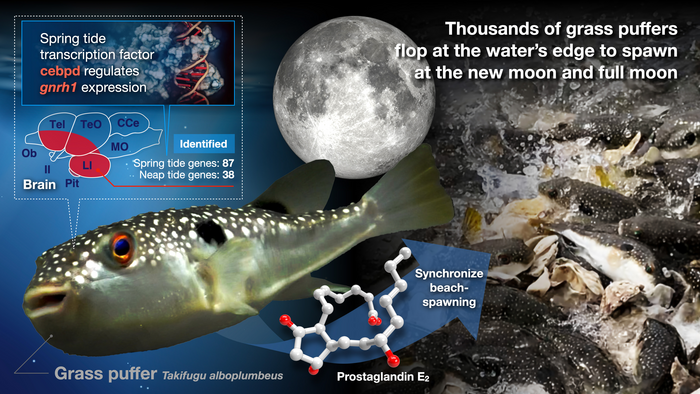A group of animal biologists and chemists at the Institute of Transformative Bio-Molecules (ITbM) at Nagoya University in central Japan, in collaboration with Toyota Boshoku Corporation and Niigata University, have identified the pheromone involved in the mechanism that triggers puffer fish to spawn on beaches using moonlight. Their findings are reported in Current Biology.

Credit: Issey Takahashi
A group of animal biologists and chemists at the Institute of Transformative Bio-Molecules (ITbM) at Nagoya University in central Japan, in collaboration with Toyota Boshoku Corporation and Niigata University, have identified the pheromone involved in the mechanism that triggers puffer fish to spawn on beaches using moonlight. Their findings are reported in Current Biology.
As described by Aristotle, people throughout history have been fascinated by the moon. Over the centuries, scientists have identified several connections between the lunar cycle and the behavior of living beings, including migration, mating, and feeding. However, while the lunar rhythm may be fundamental to life, the mechanism by which it affects behavior is not well understood.
Along coastlines around the world, at the time of the spring tide (that is, new moon and full moon), thousands of puffer fish, gather at the water’s edge and perform a writhing motion as they spawn. These fish are known as ‘semilunar spawners’. Although this dramatic display is a popular attraction, scientists do not understand the mechanism by which the puffer fish synchronize their spawning with the lunar cycle.
Therefore, to better understand this phenomenon, the Nagoya University researchers applied an innovative genomic technique, called ecogenomics, to grass puffers. They identified 125 genes involved in their spawning behavior, including genes crucial for reproduction. During the spring tide, the researchers also noticed receptors for a particular pheromone, PGE2. When they applied PGE2 to a tank of puffer fish, both males and females demonstrated their characteristic writhing behavior when spawning. Furthermore, as the dose increased, the number of responding fish also rose. The researchers concluded that the spawning puffers release PGE2 into the seawater, triggering the synchronized beach-spawning behavior.
“The synchronization of reproduction with the lunar cycle is not limited to organisms living along the shoreline,” explained lead researcher Professor Takashi Yoshimura. “For example, wildebeest mating and calf delivery in cows are also reported to be synchronized with the lunar cycle,” He believes that this kind of research also has implications for humans. “It is worth noting,” he said, “that menstrual cycles, sleep–wake cycles, and manic–depressive cycles are synchronized with the moon’s cycle in humans, and the lunar cycle generally affects human biology and behavior.”
Journal
Current Biology
DOI
10.1016/j.cub.2022.09.062
Method of Research
Experimental study
Subject of Research
Animals
Article Title
Prostaglandin E2 synchronizes lunar-regulated beach-spawning in grass puffers
Article Publication Date
27-Oct-2022




